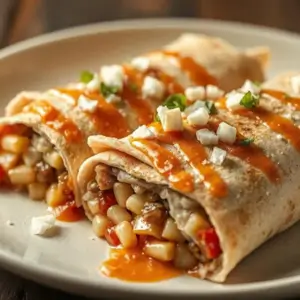Table of Contents
ToggleIntroduction
Banana bread typically includes ripe bananas, all-purpose flour, sugar, eggs, butter, baking soda, vanilla extract, and a pinch of salt. Optional add-ins include cinnamon, chocolate chips, or chopped nuts.
Tips for the Perfect recipe
- Don’t overmix: Overmixing the batter will make your banana bread dense and tough. Just mix until everything is combined.
- Use overripe bananas: The blacker, the better! Overripe bananas provide extra sweetness and a softer texture.
- Test with a toothpick: Insert a toothpick in the center of the loaf.
- Let it rest: It tends to taste better the day after baking. The flavors meld together for a richer, more complex taste.
Common Mistakes to Avoid
- Using unripe bananas: As mentioned, ripe bananas are key for sweetness and moisture. Avoid using bananas that aren’t spotty or brown yet.
- Overbaking: Keep an eye on your loaf in the oven. It should be moist, so take it out once the toothpick comes out clean.
- Ignoring measurements: Be careful not to add too much flour, which can make the bread too dense. Spoon the flour into your measuring cup instead of scooping it directly from the bag.
Skill Level
Beginner-Friendly: This recipe is perfect for anyone, even if you’re new to baking. No special techniques are needed!
Variations
- Healthier Option: Swap the all-purpose flour for whole wheat flour, use coconut oil instead of butter, and honey or maple syrup in place of sugar.
- Add-Ins: You can toss in 1/2 cup of chocolate chips, walnuts, or dried fruit (like raisins or cranberries) for extra flavor.
- Gluten-Free: Replace the all-purpose flour with a gluten-free flour blend that includes xanthan gum to help with texture.
- Vegan Version: Replace the eggs with flax eggs (1 tablespoon ground flaxseed + 3 tablespoons water = 1 egg) and use a vegan butter substitute.
General information
Storage and Shelf Life
- Room Temperature: Storeit in an airtight container for up to 3 days.
- Refrigeration: It will keep for about 5-7 days in the fridge if you prefer it chilled.
- Freezing: To freeze it, wrap it tightly in plastic wrap, then in aluminum foil, and store for up to 3 months.
Potential Allergens
- Contains gluten (if using regular all-purpose flour)
- Contains dairy (if using regular butter)
- Contains eggs
If serving to someone with allergies, be sure to use appropriate substitutes (like almond flour for gluten-free, or flax eggs for egg-free).
Origin of Banana Bread
This recipe gained popularity in the U.S. in the 1930s during the Great Depression, a time when people were looking for ways to avoid food waste. Overripe bananas that might have been discarded found new life in baked goods, thanks to the introduction of baking soda and powder.
Banana Bread’s Popularity in Modern Times
During the pandemic,it became a social media sensation, with people from all over the world sharing their unique takes on this simple yet delicious bread. It’s versatile, forgiving, and always hits the spot, making it the perfect recipe to bake at home.
Its History
Historical Significance: Banana bread rose to fame during the Great Depression, where home bakers sought to make use of overripe bananas rather than letting them go to waste. Commercially available baking soda and baking powder also contributed to its popularity, allowing for the creation of soft, quick breads without yeast.
Nutritional Benefits of Bananas
- Rich in Potassium: Bananas are high in potassium, which helps regulate blood pressure and support heart health.
- Natural Sweetener: They provide a natural source of sugar, reducing the need for additional sweeteners in the recipe.
- Good Source of Fiber: The fiber in bananas aids digestion and helps maintain blood sugar levels.
Common Troubleshooting
- Why Is it Too Dense? This typically happens when the batter is overmixed or if too much flour is added.
- Why Is it Dry? Dry banana bread can result from overbaking. Check the loaf 10 minutes before the recommended baking time is up.
Global Variations
- Jamaican Banana Bread: Often includes spices like nutmeg, cinnamon, and allspice, and may also have rum or coconut mixed in.
- Filipino Banana Cake: This version often uses local saba bananas, which are smaller and starchier, and the cake is sometimes topped with caramel or grated cheese.
- Hawaiian Banana Bread: Frequently incorporates pineapple or macadamia nuts, adding tropical flair to the traditional loaf.
Banana Bread for Different Dietary Needs
- Low-Carb Option: Substitute all-purpose flour with almond flour or coconut flour for a lower-carb version.
- Keto Banana Bread: Use almond flour, coconut flour, and a sugar substitute like erythritol or monk fruit sweetener. While bananas themselves aren’t keto-friendly, you can use banana extract to mimic the flavor.
- Sugar-Free Banana Bread: Instead of refined sugar, you can sweeten the bread with honey, maple syrup, or stevia for a sugar-free or diabetic-friendly version.
Best Practices for Slicing Banana Bread
- Use a Serrated Knife: A serrated knife is best for slicing banana bread without squishing it, especially when it’s still warm.
- Wait Until It’s Cool: Let the banana bread cool completely before slicing to prevent it from crumbling.
Sustainability Tip
Banana bread is a great way to reduce food waste by using up overripe bananas that might otherwise be thrown away. You can also get creative by adding leftover nuts, seeds, or other pantry ingredients to your loaf.
Cultural Significance of Banana Bread
- Comfort Food: Banana bread has become a universal comfort food, especially during stressful times. Its popularity surged during the COVID-19 lockdowns, where it became a symbol of home-baking trends.
- American Tradition: Though it’s enjoyed worldwide, banana bread has roots in American baking culture, closely tied to home economics and the rise of the “quick bread” genre in American kitchens.
Banana Bread Texture Options
- Crumbly vs. Dense: For a more cake-like crumbly texture, use room temperature ingredients and beat the butter and sugar longer. For a denser loaf, use melted butter and mix only until combined.
- Light and Fluffy: You can make your banana bread fluffier by adding a bit more baking soda or folding whipped egg whites into the batter. This helps to create air pockets that lift the bread while baking.
Ways to Enjoy Banana Bread
- Sandwich Style: Use banana bread slices to make sandwiches, pairing it with peanut butter, Nutella, or a thin layer of cream cheese for an interesting flavor contrast.
- With Honey Butter: Mix softened butter with honey and spread it on warm banana bread for an irresistible breakfast or snack.
- Savory Twist: Top banana bread with a small slice of brie or cheddar cheese for a unique blend of sweet and savory flavors.
Baking Science Behind Banana Bread
- The Role of Baking Soda: Baking soda helps banana bread rise by interacting with the acidity of the bananas. Make sure to use enough bananas (or a bit of yogurt or sour cream) to activate the baking soda.
- Why Bananas Make the Perfect Base: Bananas add moisture, natural sweetness, and act as a fat substitute (thanks to their creamy consistency), making them ideal for a quick bread recipe.
Serving Size Adjustments
- Mini Loaves: Instead of a full loaf, divide the batter into mini loaf pans. Mini loaves bake faster and are perfect for gifting or portion control.
- Muffin Version: Transform the banana bread batter into banana muffins. They take about 15-20 minutes to bake, offering an easy grab-and-go option.
- Double Batch: You can double the recipe to make two loaves. If doing this, make sure to properly adjust the baking time and keep an eye on the doneness.
Frequently Asked Questions (FAQ)
What is the formula for it? The basic formula for banana bread is mixing mashed ripe bananas with a fat (usually butter), sugar, eggs, and a rising agent like baking soda. The combination of dry and wet ingredients creates a thick batter, which is baked to perfection, yielding a soft, moist bread.
Is it made of bananas? Yes! The main ingredient in banana bread is mashed bananas. They are responsible for the bread’s moisture, sweetness, and signature banana flavor.
Why Banana Bread Is So Popular? It is a go-to recipe because it is:
- Versatile: You can add ingredients like chocolate chips, walnuts, or even swap some flour with oats or almond meal for a healthier twist.
- Quick to make: With just 10 minutes of prep time, it’s perfect for busy schedules.
- A great way to use overripe bananas: Don’t throw those spotty bananas away! The ripper they are, the sweeter and more flavorful your banana bread will be.
What Makes Banana Bread Different from Other Quick Breads? Moisture Content: Banana bread stands out for its high moisture content due to the bananas, butter, and eggs. This is why it’s important not to overbake it, as the bread can dry out.
- Sweetness: Bananas naturally sweeten the bread, reducing the need for excessive added sugar.
- Flavor Profile: The dominant flavor is banana, but hints of vanilla and cinnamon (if used) enhance the overall taste.
Why it Is a Great Food for Kids?
- Soft Texture: Banana bread is easy for young children to chew and digest, making it an ideal snack or breakfast option.
- Involves Simple Steps: The recipe is easy to follow and offers a fun baking activity for kids. They can help mash the bananas or mix the batter.
- Naturally Sweet: With ripe bananas and minimal added sugar, banana bread is a healthier alternative to sugary snacks.
How to Ripen Bananas Quickly?
- Bake them: Place bananas (in their skins) on a baking sheet and bake in a 300°F (150°C) oven for 15-20 minutes until they turn black. Let them cool before using.
- Paper bag trick: Place bananas in a brown paper bag with an apple or ripe banana.
Still hungry? Check-out these recipes:

Banana bread
Equipment
- Large mixing bowl
- Whisk or electric mixer
- Loaf pan (9x5 inches)
- Oven
Ingredients
- 3 ripe bananas, mashed
- 2 large eggs
- 1/2 cup unsalted butter, melted
- 1 teaspoon vanilla extract
- 1 teaspoon baking soda
- 1/4 teaspoon salt
- 1 1/2 cups all-purpose flour
- 3/4 cup granulated sugar, can use brown sugar for added moisture and flavor
Instructions
- Preheat the oven to 350°F (175°C).
- Mash the ripe bananas in a large bowl until smooth. Add melted butter and mix well.
- Mix in the sugar, eggs, and vanilla extract until combined.
- In a separate bowl, combine flour, baking soda, salt, and cinnamon (if using).
- Gradually fold the dry ingredients into the wet mixture until everything is just combined. Be careful not to overmix—this can lead to a denser loaf.
- Transfer the batter to the greased loaf pan, smoothing the top to ensure an even layer.
- Bake for 50 to 60 minutes, or until a toothpick inserted into the center comes out clean or with a few moist crumbs attached.
- Allow the banana bread to cool in the pan for 10 minutes, then carefully move it to a wire rack to cool fully before slicing.







